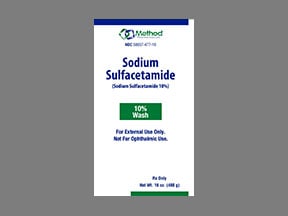
Sodium Sulfacetamide Wash Coupons & Savings Card – Discount Prices from $2.92
This medication is designed for skin cleansing and is effective in treating dandruff and various skin conditions, including seborrheic dermatitis. Additionally, it is used to address specific bacterial skin infections. Sulfacetamide, the active ingredient, is a sulfonamide antibiotic that works by inhibiting bacterial growth.
Our coupons are free to use. Before paying, show the pharmacist your Sodium Sulfacetamide Wash savings card to get your free discount. Use our filters below to edit the prescription box to match your needs. The Sodium Sulfacetamide Wash prices will update based on your prescription needs. Above our Sodium Sulfacetamide Wash coupons, you can change your location to see pharmacy prices and costs in other areas. We're here to help you buy Sodium Sulfacetamide Wash at the lowest price with our prescription discount card.
My prescription
Edit
177GM of 10%, Sodium Sulfacetamide Wash (1 Bottle)
Select pharmacy

CVS
$39.95
COUPON PRICE
Walmart
$2.92
COUPON PRICE
Walgreens
$28.89
COUPON PRICE
Albertsons
$37.82
COUPON PRICESodium Sulfacetamide Wash savings card
Show this card to your pharmacist
Walmart
$2.92
BIN
ID
PCN
GRP
019876
LHDD45BFB1
CHIPPO
LHX
Powered by
This medication is designed for skin cleansing and is effective in treating dandruff and various skin conditions, including seborrheic dermatitis. Additionally, it is used to address specific bacterial skin infections. Sulfacetamide, the active ingredient, is a sulfonamide antibiotic that works by inhibiting bacterial growth.
Our coupons are free to use. Before paying, show the pharmacist your Sodium Sulfacetamide Wash savings card to get your free discount. Use our filters below to edit the prescription box to match your needs. The Sodium Sulfacetamide Wash prices will update based on your prescription needs. Above our Sodium Sulfacetamide Wash coupons, you can change your location to see pharmacy prices and costs in other areas. We're here to help you buy Sodium Sulfacetamide Wash at the lowest price with our prescription discount card.
More prescriptions for skin infection
coupons from$2.68Save 85%
coupons from$11.43Save 96%
coupons from$25.59Save 87%
coupons from$25.40Save 67%
coupons from$50.69Save 77%
coupons from$97.73Save 29%
coupons from$2096.69Save 72%
coupons from$5.50Save 66%
More prescriptions for skin infection
Centany Save 85%coupons from $2.68
Ceftriaxone Save 96%coupons from $11.43
Minocin Save 87%coupons from $25.59
Cefprozil Save 67%coupons from $25.40
Hydrocortisone-iodoquinol Save 77%coupons from $50.69
Cetraxal Save 29%coupons from $97.73
Noritate Save 72%coupons from $2096.69
Amoxicillin Save 66%coupons from $5.50
Our coupons are free to use. Before paying, show the pharmacist your Sodium Sulfacetamide Wash savings card to get your free discount. Use our filters below to edit the prescription box to match your needs. The Sodium Sulfacetamide Wash prices will update based on your prescription needs. Above our Sodium Sulfacetamide Wash coupons, you can change your location to see pharmacy prices and costs in other areas. We're here to help you buy Sodium Sulfacetamide Wash at the lowest price with our prescription discount card.
Sodium Sulfacetamide Wash dosage forms
Use our Sodium Sulfacetamide Wash 177GM of 10% coupon with prices from $2.92 for 1 Bottle. You can also use our Sodium Sulfacetamide Wash 177GM of 10% coupon with prices from $10.82 for 2 Bottles. We have a Sodium Sulfacetamide Wash 177GM of 10% coupon with prices from $18.73 for 3 Bottles.
Dosage Quantity Price from Per unit 177GM of 10% 1 Bottle $2.92 $2.92 177GM of 10% 2 Bottles $10.82 $5.41 177GM of 10% 3 Bottles $18.73 $6.24
| Dosage | Quantity | Price from | Per unit |
|---|---|---|---|
| 177GM of 10% | 1 Bottle | $2.92 | $2.92 |
| 177GM of 10% | 2 Bottles | $10.82 | $5.41 |
| 177GM of 10% | 3 Bottles | $18.73 | $6.24 |
Sodium Sulfacetamide Wash Warnings
When taking this medication, it is important to be aware of its potential interactions and usage guidelines to ensure safety and effectiveness. Consider the following points:
- Potential Interactions: Avoid using topical products containing silver, such as silver sulfadiazine, as they may interact with this drug.
Always consult with a healthcare provider for personalized advice and if you have any questions or concerns regarding the use of this medication.
Sodium Sulfacetamide Wash Side Effects
Common side effects:
- Redness on the skin
- Stinging sensation on the skin
- Burning sensation on the skin
Less common but important to monitor:
- Fungal skin infection
Serious side effects:
- Joint pain
- Butterfly-shaped rash on the face
- Fever
- Mouth sores
- Persistent sore throat
- Unusual fatigue
- Unexpected bleeding or bruising
- Dark urine
- Yellowing of the eyes and skin
- Severe allergic reaction
Sodium Sulfacetamide Wash Interactions
This medication may interact with topical products that include silver, such as Silver Sulfadiazine.
